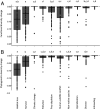The decline of mammal functional and evolutionary diversity worldwide
- PMID: 33397807
- PMCID: PMC7826328
- DOI: 10.1073/pnas.1921849118
The decline of mammal functional and evolutionary diversity worldwide
Abstract
Biodiversity is declining worldwide. Because species interact with one another and with their environment, losses of particular organisms alter the function of ecosystems. Our understanding of the global rates and specific causes of functional decline remains limited, however. Species losses also reduce the cumulative amount of extant evolutionary history ("phylogenetic diversity" [PD]) in communities-our biodiversity heritage. Here we provide a global assessment of how each known anthropogenic threat is driving declines in functional diversity (FD) and PD, using terrestrial mammals as a case study. We find that habitat loss and harvest (e.g., legal hunting, poaching, snaring) are by far the biggest drivers of ongoing FD and PD loss. Declines in FD in high-biodiversity countries, particularly in Southeast Asia and South America, are greater than would be expected if species losses were random with respect to ecological function. Among functional guilds, herbivores are disproportionately likely to be declining from harvest, with important implications for plant communities and nutrient cycling. Frugivores are particularly likely to be declining from both harvest and habitat loss, with potential ramifications for seed dispersal and even forest carbon storage. Globally, phylogenetically unique species do not have an elevated risk of decline, but in areas such as Australia and parts of Southeast Asia, both habitat loss and harvest are biased toward phylogenetically unique species. Enhanced conservation efforts, including a renewed focus on harvest sustainability, are urgently needed to prevent the deterioration of ecosystem function, especially in the South American and equatorial Asian tropics.
Keywords: bushmeat hunting; conservation; habitat loss; harvest; phylogenetic diversity.
Conflict of interest statement
The authors declare no competing interest.
Figures




Similar articles
-
Habitat destruction and overexploitation drive widespread declines in all facets of mammalian diversity in the Gran Chaco.Glob Chang Biol. 2021 Feb;27(4):755-767. doi: 10.1111/gcb.15418. Epub 2020 Dec 1. Glob Chang Biol. 2021. PMID: 33258510
-
Using historical habitat loss to predict contemporary mammal extirpations in Neotropical forests.Conserv Biol. 2024 Aug;38(4):e14245. doi: 10.1111/cobi.14245. Epub 2024 Mar 8. Conserv Biol. 2024. PMID: 38456548
-
Bushmeat biogeochemistry: hunting tropical mammals alters ecosystem phosphorus budgets.Proc Biol Sci. 2019 Jul 24;286(1907):20190966. doi: 10.1098/rspb.2019.0966. Epub 2019 Jul 17. Proc Biol Sci. 2019. PMID: 31311475 Free PMC article.
-
Predicting loss of evolutionary history: Where are we?Biol Rev Camb Philos Soc. 2017 Feb;92(1):271-291. doi: 10.1111/brv.12228. Epub 2015 Oct 14. Biol Rev Camb Philos Soc. 2017. PMID: 26467982 Review.
-
Phylogenetic diversity as a window into the evolutionary and biogeographic histories of present-day richness gradients for mammals.Philos Trans R Soc Lond B Biol Sci. 2011 Aug 27;366(1576):2414-25. doi: 10.1098/rstb.2011.0058. Philos Trans R Soc Lond B Biol Sci. 2011. PMID: 21768156 Free PMC article. Review.
Cited by
-
Changes in community composition and functional diversity of European bats under climate change.Conserv Biol. 2025 Aug;39(4):e70025. doi: 10.1111/cobi.70025. Epub 2025 Apr 1. Conserv Biol. 2025. PMID: 40165613 Free PMC article.
-
Ecological function maintained despite mesomammal declines.Sci Rep. 2024 Aug 24;14(1):19668. doi: 10.1038/s41598-024-66534-8. Sci Rep. 2024. PMID: 39181911 Free PMC article.
-
Diel niche variation in mammalian declines in the Anthropocene.Sci Rep. 2023 Jan 19;13(1):1031. doi: 10.1038/s41598-023-28104-2. Sci Rep. 2023. PMID: 36658287 Free PMC article.
-
Global importance of Indigenous Peoples, their lands, and knowledge systems for saving the world's primates from extinction.Sci Adv. 2022 Aug 12;8(32):eabn2927. doi: 10.1126/sciadv.abn2927. Epub 2022 Aug 10. Sci Adv. 2022. PMID: 35947670 Free PMC article. Review.
-
How do invasive predators and their native prey respond to prescribed fire?Ecol Evol. 2024 May 22;14(5):e11450. doi: 10.1002/ece3.11450. eCollection 2024 May. Ecol Evol. 2024. PMID: 38783847 Free PMC article.
References
-
- Tilman D., et al. , Future threats to biodiversity and pathways to their prevention. Nature 546, 73–81 (2017). - PubMed
-
- WWF Ed. , Living Planet Report—2018: Aiming Higher, Grooten M. and Almond R. E. A., Eds. (World Wildlife Fund for Nature, 2018).
-
- Pimm S. L., et al. , The biodiversity of species and their rates of extinction, distribution, and protection. Science 344, 1246752 (2014). - PubMed
Publication types
MeSH terms
LinkOut - more resources
Full Text Sources
Other Literature Sources

